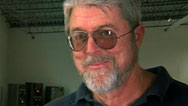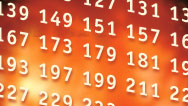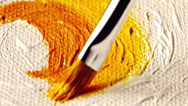Kryptos
- Posted 07.24.07
- NOVA scienceNOW
(This video is no longer available for streaming.) The most enigmatic of all codes in the most clandestine of all places has yet to be fully broken. "Kryptos," a coded sculpture in the courtyard of CIA headquarters in Langley, Virginia, contains a long string of seemingly nonsensical letters that conceal a message devised by sculptor James Sanborn. Some portions have been deciphered, but the last bit remains a mystery. Solutions anyone?
Transcript
Kryptos
PBS air date: July 24, 2007
NEIL DEGRASSE TYSON: Most good spy stories have a secret message, usually in code, but a master spy can always crack it. Today, code breaking involves complex mathematics and relies on powerful algorithms. But even with the best technology, there's one coded message no one has been able to crack. It's ten feet tall and sitting in plain view, in the backyard of the CIA.
Correspondent Cohen, Chad Cohen, is on the case.
CHAD COHEN: Of all the secrets hidden at the highly-secured CIA headquarters in Langley, Virginia, you may be looking at one of the strangest. Meet Kryptos. It's a copper monolith inscribed with nearly two thousand very random-looking characters, but there's a message here, if you can break the code. And despite countless attempts since Kryptos' 1989 installation, that has yet to be done.
JAMES SANBORN: Now, you're the Central Intelligence Agency, right? You're supposed to be very intelligent. Everybody there is intelligent, right? You don't have anything pulled over your eyes.
CHAD COHEN: Well that's at least what we all like to believe. But with Kryptos, that's exactly what Jim Sanborn has done. And he is not the world's most sophisticated cryptographer. In fact, Sanborn is not a cryptographer at all. The mastermind behind Kryptos is an artist, if an unconventional one. His workspace looks more science lab than art studio.
JAMES SANBORN: I worked with lodestones, compasses, the Earth's magnetic field, the Coriolis force. These were natural forces that were invisible. Those kinds of things fascinated me, and I set about to try to make those things visible for people.
CHAD COHEN: When the CIA was looking for a sculpture to grace the courtyard of their new headquarters building, Sanborn wanted to design something that would stay invisible, a secret code. So how does an artist craft a message that the best code breakers in the world can't crack?
ED SCHEIDT (Former CIA Cryptologist): I set the codes out for him, which means he didn't have to know the mathematics of it.
CHAD COHEN: Sanborn found help in the former chairman of the CIA cryptographic center, Ed Scheidt, who gave Jim a crash course in Cryptography 101.
ED SCHEIDT: Well classical cryptography—and it's been defined this way—includes substitution and it includes transposition.
CHAD COHEN: For substitution, take one letter or word and swap it for another; transposition: keep the letters the same, just systematically mix them up. Pretty straightforward tricks and yet they've been stumping would-be code breakers for thousands of years.
Julius Caesar came up with a system based on substitution to send secret messages to his generals on the battlefield. It's called the Caesar cipher.
ED SCHEIDT: A letter is substituted with another letter. By laying two alphabets on top of each other, and shifting one of them over a set number of places, you get a whole new alphabet.
CHAD COHEN: The word "film" in this case, now becomes "ilop," complete gobbledygook if intercepted by any enemy. But if you know how many spaces to shift the alphabet over, it's clear as day.
The codes have gotten more complicated through the ages. Nazi Germany's enigma machine, for example, which Hitler used successfully for years before allied code breakers cracked it, employed a mechanical rotor system. Ultimately, it just created elaborate substitutions.
Transposition ciphers have their place in history too. To send secret messages to his army, General Ulysses S. Grant didn't substitute letters he just carefully mixed them all up.
Sanborn also employed this technique in Kryptos using pen and paper.
JAMES SANBORN: So this is the plain text, this is the way it's written out in English.
CHAD COHEN: By writing the message on a grid, and transposing it to different positions on a new grid, it becomes unreadable to someone trying to intercept it. And the more times you do it, the more complex it can get.
JAMES SANBORN: So it can get very complicated.
CHAD COHEN: Very quickly, it seems.
JAMES SANBORN: Very quickly.
CHAD COHEN: Complicated, maybe, to a code breaker, but it's very simple to the intended recipient. If the code is meant for you, you don't have to break it. Because when two parties want to communicate via cipher, they agree ahead of time on the specific rules of the system. With transposition, you might agree on how many rows you'd use or how many times the chart is flipped. With substitution, you might agree on how many spaces to offset the alphabet.
To make Kryptos, Sanborn took both these techniques, used them to encode four distinct messages, and cut them into copper.
JAMES SANBORN: Every letter was cut out with a jigsaw, and it took two and a half years of cutting to do it.
CHAD COHEN: Secure as the CIA may be, it wasn't long before Kryptos went mainstream. Through internet message boards, Web sites, hacker conventions, Kryptos has become a phenomenon.
ELONKA DUNIN: We have a group of about a thousand people around the world that are brainstorming this very, very heavily.
CHAD COHEN: Elonka Dunin, whose Web site has had millions of hits from would-be crackers, is generally considered to be the leading Kryptos expert in the world, even Sanborn says so. But she's only seen the sculpture up close once.
ELONKA DUNIN: Well, because we can't get in to see Kryptos at CIA, because it's at the center of CIA.
CHAD COHEN: So, Elonka took me here, to the Hirshhorn Museum in Washington D.C. to see a similar Sanborn piece, called Antipodes.
ELONKA DUNIN: So, this is the next best thing. The order of the letters is identical. The punctuation is the same. Part one starts here, where it says, where it says "emufphz" decrypts to the letters "b, e, t, w, e, e, n."
CHAD COHEN: Between? Since when does "emufphz" resemble anything like the word "between?" Well, since Parts One, Two and Three of Kryptos were cracked in 1999.
JIM GILLOGLY (Code Breaker): It all looks like pretty much garbage to the untrained eye.
CHAD COHEN: And here's the guy who did it, L.A. computer scientist Jim Gillogly.
JIM GILLOGLY: Part of the reason it's developed a cult following is that I was able to crack it and expose it to the world. So people are able to say, "Look, some of it really is solvable. It's not just a mass of garbage letters."
CHAD COHEN: Gillogly's programs combine algorithms with rules of thumb for English grammar and spelling. The computer tries millions of different character combinations and throws away the ones that look like nonsense. He's cracked many codes in his life, but he always starts the same way, with what's called a frequency count.
Simply put, he counts. He counts up all the letters in the text and sees how often each one occurs. That works because, in any language, certain letters always show up more often than others. Whether it's a cookbook, a flight manual, or a page from Hamlet, the frequency of each letter will always stay about the same.
So, in English, on average, of all the letters in any given bit of text, Es make up over 12 percent, while Qs occur much less frequently, less than .2 percent.
When Gillogly studied the first two parts of Kryptos, he noticed there were just as many Qs as there were Es. It was a tip-off that they were probably standing in for, or substituting for, more common letters. Gillogly ran his program on it.
Okay, so you typed this stuff in, you typed in that code, and, boom, this came out.
JIM GILLOGLY: This came out.
CHAD COHEN: But as the solution for Parts One and Two came out on Jim Gillogly's screen, the mystery just got deeper.
JIM GILLOGLY: "Between subtle shading and the absence of light, lies the nuance of illusion."
JAMES SANBORN: "It was totally invisible. How's that possible? They used the Earth's magnetic field. The information was gathered and transmitted underground to an unknown location."
JIM GILLOGLY: This was his last message.
CHAD COHEN: Hmm, another one to scratch your head on, right?
ELONKA DUNIN: Yes, there's a lot of "hmms" here, definitely.
CHAD COHEN: There was nothing to help reveal the meaning of the sculpture, just the ambiguous words of Jim Sanborn; not that it mattered to the man who actually cracked it.
JIM GILLOGLY: For myself, personally, I don't care quite so much about what was being hidden as how it was hidden.
CHAD COHEN: Gillogly quickly discovered that Part Three of Kryptos was hidden in a radically different way. This one had lots of E's and only one Q, just like it would be in English.
JIM GILLOGLY: I could tell that it was a transposition cipher because the frequency of the letters was identical to the frequency in English.
CHAD COHEN: Remember what Sanborn was doing in his studio? The transposition he did with that graph paper? Gillogly created a computer program that undid it, and eventually he cracked Part Three of Kryptos as well.
This section was recognizable, taken right out of archaeologist Howard Carter's notebook, describing the moment he first opened King Tut's tomb.
ELONKA DUNIN: "Slowly, slowly, desperately slowly, the remains of passage debris that encumbered the lower part of the doorway was removed."
JIM GILLOGLY: "And then, widening the hole, a little I inserted the candle and peered in. The hot air escaping from the chamber caused the flame to flicker, but presently details of the room within emerged from the mist."
CHAD COHEN: Diary excerpts from famous explorers, mysterious allusions to light and dark. Even when Sanborn's words are put in the right order, they are cryptic, to say the least.
Between "subtle shadings," and the Howard Carter, what does it mean?
ELONKA DUNIN: Well, they all tend to have a common theme of things hidden, things underground, things concealed from sight. So that theme may be something that is going to give us a clue towards Part Four.
CHAD COHEN: Part Four is made up of the final 98 letters on the sculpture, and only by breaking that last piece will the true message of Kryptos be revealed. But so far, it has proven impervious to all the techniques of would-be code breakers.
ELONKA DUNIN: Part Four is hard, well, number one, because it's very short. It's only 97 or 98 characters. When cryptanalysts are working on a code, we generally have a large amount of cipher text to work with. Then you're able to look for the very subtle mathematical patterns, which is what takes a code apart.
CHAD COHEN: Is it something really simple that people are missing?
JAMES SANBORN: No, I...maybe not...maybe, maybe not.
CHAD COHEN: And he may have had one more trick up his sleeve, something called concealment.
JIM GILLOGLY: It could be a matter of obfuscating the language before starting to encrypt.
ELONKA DUNIN: Ed Scheidt has said that he used a little bit of concealment on Part Four, but we don't know what that means.
CHAD COHEN: A message can be concealed in various ways before enciphering it, to make it even harder to break.
ED SCHEIDT: The first challenge then is, well, what masking technique was used?
CHAD COHEN: Techniques like removing all the vowels first, or spelling the message phonetically, can radically undermine the code-breaking methods. So, it may still be a long time before anyone experiences the thrill of cracking all of Kryptos. Even Ed, who taught Jim how to make code, doesn't know the solution, which makes Jim Sanborn the only person on earth who does. And he isn't dropping any hints.
It wouldn't help to just kind of get it out there?
JAMES SANBORN: Unburden myself?
CHAD COHEN: Lighten your load?
JAMES SANBORN: Oh, no, no, no, no. Unh unh. I really like your program, but I'm sorry.
Credits
Kryptos
- Edited by
- David Chmura
- Produced by
- Win Rosenfeld
NOVA scienceNOW
- Executive Producer
- Samuel Fine
- Executive Editor
- Neil deGrasse Tyson
- Senior Series Producer
- Vincent Liota
- Supervising Producer
- Stephen Sweigart
- Editorial Producer
- Julia Cort
- Development Producer
- Vinita Mehta
- Senior Editor
- David Chmura
- Production Assistant
- Alison Snyder
- Production Secretary
- Fran Laks
- Animator
- Brian Edgerton
- Compositor
- Yunsik Noh
- Music
- Rob Morsberger
- Associate Producers
- John
Pavlus
Gitanjali Rege - Camera
Andreas Bremer
Brian Dowley
Mark Falstad
Edward Marritz
Dusty Powers
Brett Wiley- Sound Recordists
-
Sven Ehling
Heidi Hesse
Brooks Lester
Mark Mandler
Paul Rusnak
George Shafnacker - Co-Producer/Researcher for Epigenetics
- Ethan Herberman
- Animation and Graphics for Epigenetics
- Sputnik Animation
Dan Nutu, Fotografis - Colorist
- Jim Ferguson
- Audio Mix
- Jim Sullivan
- NOVA scienceNOW series animation
- Edgeworx
- Archival Material
- Arlie Petters
The Belize Times
European Space Agency
Frank Summers/Space Telescope Science Institute
Great Belize Productions Ltd. – Channel 5
Les Todd/Duke University
M. Kornmesser and L.L. Christensen/Hubble European Space Agency Information Centre
NASA
Observatories of the Carnegie Institution of Washington - Special Thanks
- Hirshhorn Museum and
Sculpture Garden
Hrana Janto
International Spy Museum
Museum of the Rockies - Neil deGrasse Tyson
- is director of the Hayden Planetarium in the Rose Center for Earth and Space at the American Museum of Natural History.
- NOVA Series Graphics
- yU + co.
- NOVA Theme Music
- Walter Werzowa
John Luker
Musikvergnuegen, Inc. - Additional NOVA Theme Music
- Ray Loring
- Post Production Online Facility
- The OutPost
- Closed Captioning
- The Caption Center
- NOVA Administrator
- Ashley King
- Publicity
- Eileen Campion
Anna Lowi
Yumi Huh
Lindsay de la Rigaudiere - Researcher
- Gaia Remerowski
- Production Coordinator
- Linda Callahan
- Paralegal
- Raphael Nemes
- Talent Relations
-
Scott Kardel, Esq.
Janice Flood - Legal Counsel
- Susan Rosen Shishko
- Assistant Editor
- Alex Kreuter
- Associate Producer, Post Production
- Patrick Carey
- Post Production Supervisor
- Regina O'Toole
- Post Production Editor
- Rebecca Nieto
- Post Production Manager
- Nathan Gunner
- Business Managers
- Joseph P. Tracy
Carla Raimer - Producer, Special Projects
- Lisa Mirowitz
- Coordinating Producer
- Laurie Cahalane
- Senior Science Editor
- Evan Hadingham
- Senior Series Producer
- Melanie Wallace
- Managing Director
- Alan Ritsko
- Senior Executive Producer
- Paula S. Apsell
This material is based upon work supported by the National Science Foundation under Grant No. 0229297. Any opinions, findings, and conclusions or recommendations expressed in this material are those of the author(s) and do not necessarily reflect the views of the National Science Foundation.
NOVA scienceNOW is a trademark of the WGBH Educational Foundation
NOVA scienceNOW is produced for WGBH/Boston by NOVA
© 2007 WGBH Educational Foundation
All rights reserved
Participants
- Chad Cohen
- Correspondent
- Elonka Dunin
- Author, Secret Codes
- Jim Gillogly
- Codebreaker
- James Sanborn
- Kryptos creator elonka.com/kryptos/sanborn.html
- Ed Scheidt
- Former CIA Cryptologist
Related Links
-

Kryptos: Expert Q&A
James Sanborn, creator of the Kryptos puzzle, answers questions about making—and breaking—codes.
-

Cryptography 101
Learn different ways to make a message secret.
-

Send a Secret Message
Write a note, encode it, and send it to a friend for decoding.
-

A Quantum Leap in Computing
MIT's Seth Lloyd, a pioneer of quantum computing, explains its applications and revolutionary potential.
-

Twin Prime Conjecture
New insight into a 2,300-year-old mystery surrounding prime numbers inspires a song.
-

Art Authentication
See if clever computer algorithms can distinguish a master forgery from a masterpiece.



